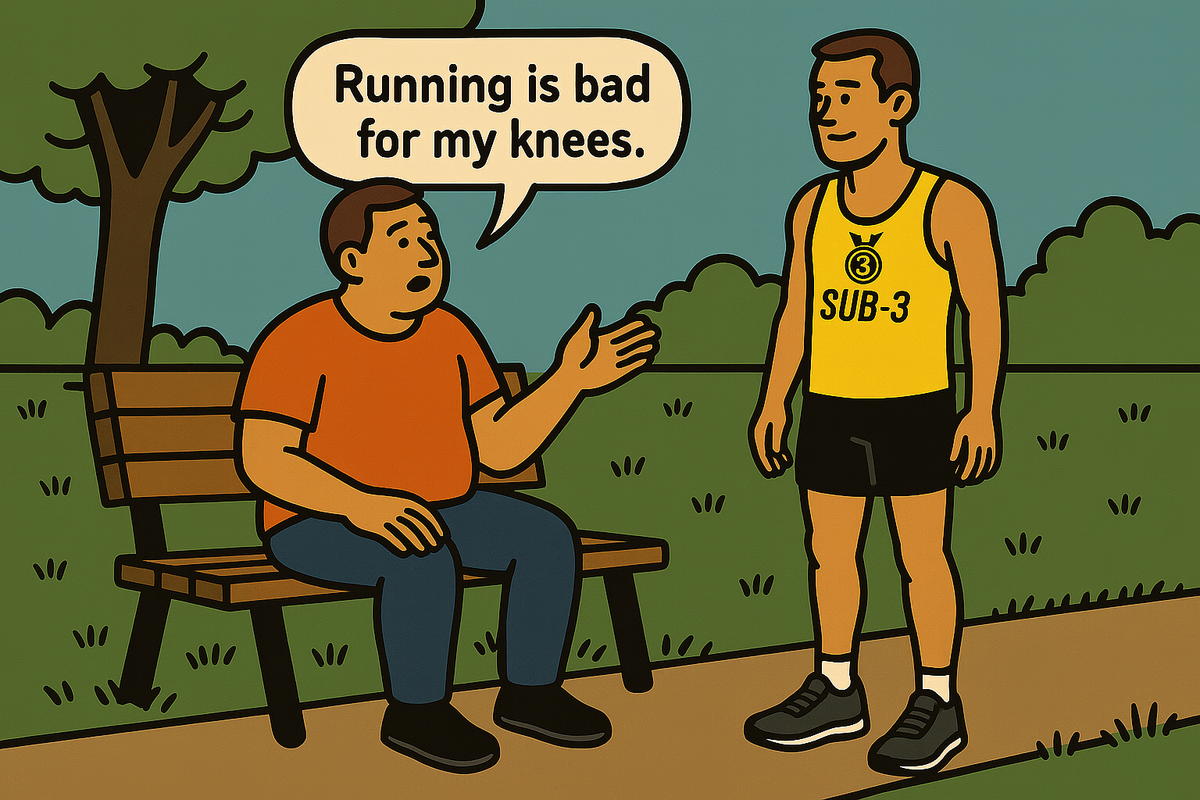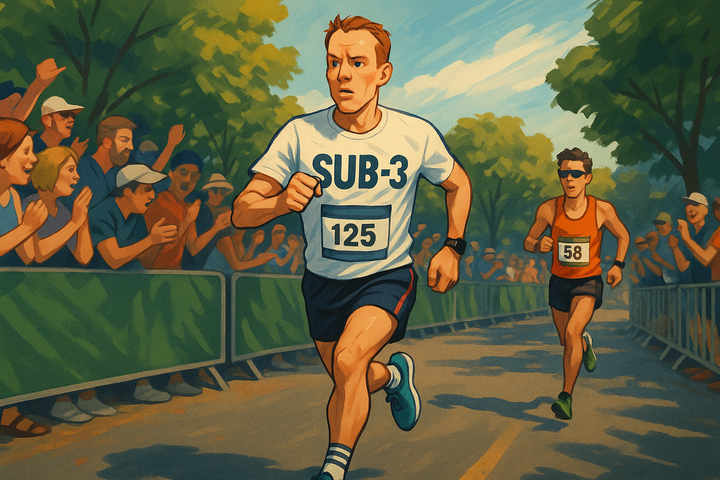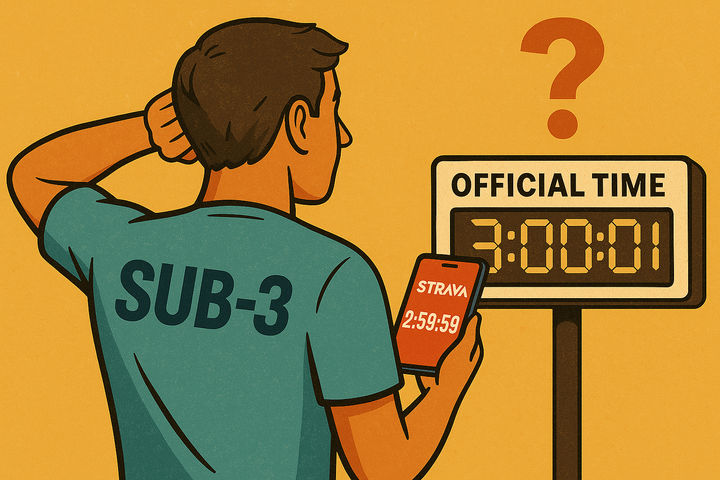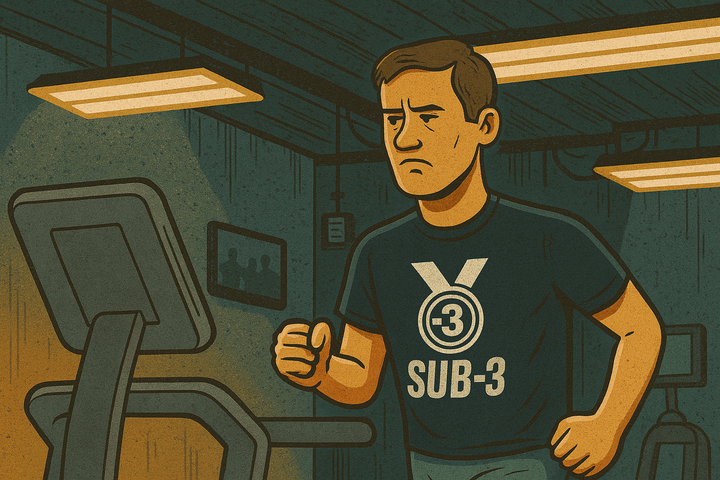Is sub-3 marathon training bad for your knees?
Why the most common excuse for not running doesn’t hold up – and what your knees actually need instead.

“I’d love to run a marathon, but my knees just wouldn’t take it.”
“I’d go for sub-3, but I did too much football as a kid – they’re shot.”
“A marathon? That’s basically signing up for a knee replacement.”
I’ve lost count of the number of times I’ve heard some version of this – usually from well-meaning friends in their 30s or 40s who use the treadmill occasionally and still feel vaguely guilty about their gym membership. It’s a line delivered with sincerity, often with a touch of regret. But it’s based on a myth. And it’s one that refuses to die.
Let’s be clear: the science is overwhelming. Recreational running doesn’t damage your knees – in fact, it seems to protect them. Study after study has shown that runners have lower rates of osteoarthritis than non-runners. One meta-analysis of over 100,000 participants found that regular runners were less likely to develop knee arthritis than people who didn’t run at all. There’s a growing body of evidence showing that consistent, moderate running strengthens the tissues around the knee, improves joint function and may even help preserve cartilage.
So why does this myth stick? Partly because it sounds intuitively plausible – running is impact, knees absorb impact, therefore running must wreck knees. And partly because it gives people an easy way out. If you don’t want to run, that’s fine. No one has to. But blaming your knees gives the decision a kind of medical legitimacy. It transforms a lack of desire, or a fear of failure, into something more noble: I would, but I physically can’t.
I get it. Running a marathon – especially sub-3 – sounds extreme if your baseline is a few scattered 5Ks. It’s easier to imagine your joints collapsing than to imagine building the training habits that would support them. But that’s the point. Your knees aren’t the problem. It’s the sudden spikes in volume, the lack of strength work, the months of inactivity before launching into a couch-to-marathon plan.
I’ve trained through six sub-3 marathon blocks now – and I’ve had exactly one minor knee issue. It came right after my first sub-3, when I unwisely decided to race a 10K a few days after the marathon. I felt a strange floaty sensation around my right kneecap. A physio visit confirmed what I already suspected: I hadn’t let my body recover. The remedy wasn’t quitting running – it was rest, a bit of rehab, and a renewed focus on strength work. Within days I was running again. Within weeks I was racing.
Since then – nothing. No pain, no tightness, no clicking. Just strong, stable knees carrying me through up to 200km a week. Not because of good genes (though I’ve had that one too – “Your mum runs marathons in her 70s? Must be genetic.”) but because I train properly. I build up slowly, I lift weights, I don’t ignore warning signs. This isn’t biology – it’s behaviour.
Of course, there are exceptions. People with major structural issues, surgeries, serious trauma. But they’re rare. And most of the people I hear voicing concerns about their knees haven’t tested them properly in years. What they really mean is: I’m worried it’ll hurt, or I’m worried I’ll fail. Both are fair. But don’t blame the knees.
So is sub-3 marathon training bad for your knees? No – quite the opposite. Done properly, it strengthens the muscles, tendons and ligaments that support them. It builds resilience over time. And it teaches you that your knees – like the rest of you – are capable of far more than you’ve been led to believe.
Five Ways To Strengthen 'Weak' Knees
- Build up gradually
Sudden spikes in training load are one of the biggest causes of knee issues. Stick to the 10% rule: increase weekly mileage by no more than 10% at a time, and prioritise consistency over hero sessions. - Do strength work twice a week
Focus on exercises that build the muscles around the knee – especially the quads, hamstrings, glutes and calves. Squats, lunges, step-ups and hamstring curls are your friends. Don’t skip them. - Train your single-leg stability
Running is a series of single-leg impacts. Exercises like single-leg Romanian deadlifts, balance drills and lateral hops improve joint control and reduce wobble – key to protecting the knee. - Stay mobile and stretch smart
Tight hips, hamstrings or calves can throw off your running mechanics and shift strain to the knees. Daily mobility work and post-run stretching help maintain healthy movement patterns. - Listen to your body – and act early
Mild discomfort after a hard session can be normal. Persistent pain, clicking or swelling isn’t. Don’t ignore it. A short break, some rehab, and a reset in training load can save you months of frustration.
Enjoyed this article? Help keep Sub-3 running — support us with a coffee.
To help fund the running of the site, Sub-3 is an Amazon Associate and earns from qualifying purchases. We only recommend gear or kit that has genuinely helped in our own running and that we believe is worth considering.



